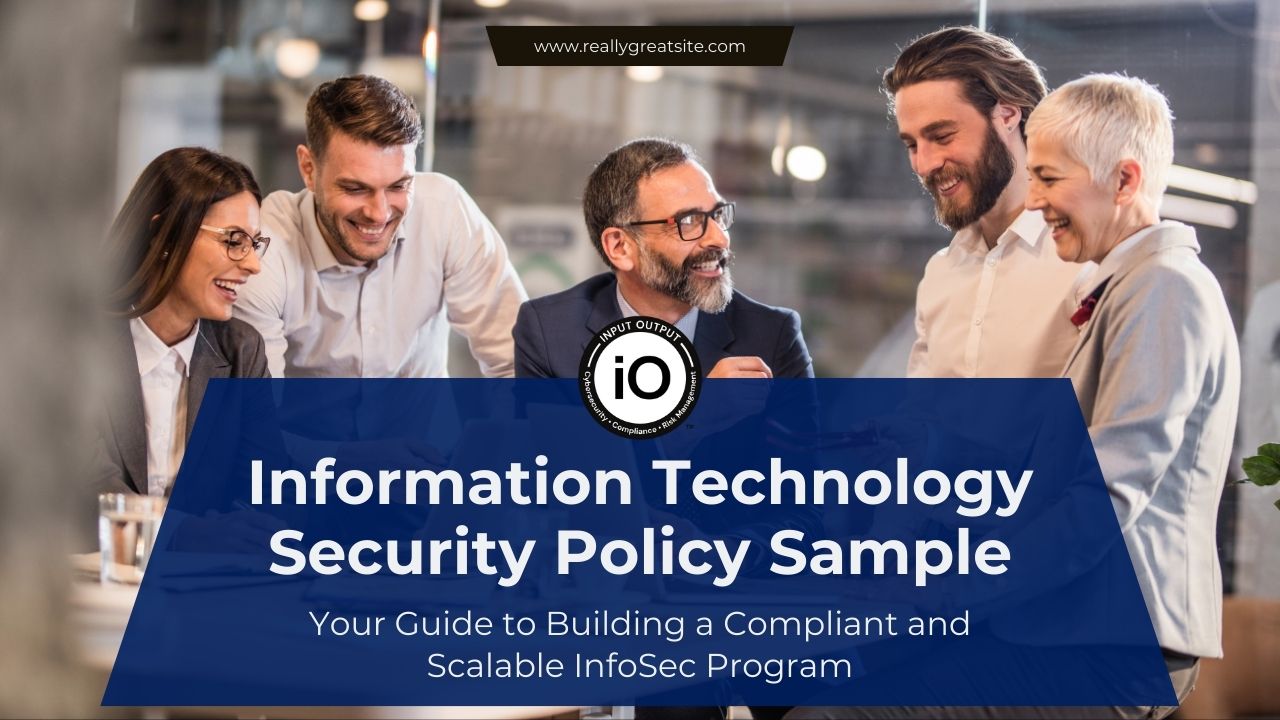Information Technology Security Policy Sample: Your Guide to Building a Compliant and Scalable InfoSec Program
May 08, 2025
As cybersecurity threats increase and regulatory expectations rise, businesses of all sizes are expected to implement strong, documented information security policies that address risks, safeguard sensitive data, and prove due diligence. Whether you're a one-person financial advisor firm or a 500-employee SaaS provider, having an information technology security policy isn’t optional—it’s foundational.
In this post, we’ll walk through:
-
What makes a good information security policy
-
Practical examples and key policy elements
-
Differences between small and large business execution
-
An industry-standard structure based on our proprietary iO-GRCF™
-
A downloadable policy sample to get you started fast
Let’s make sense of it all—without sounding like a lawyer wrote it.
🔐 What Is a Security Policy (And Why It’s Not Just for Enterprises)?
A security policy is a written plan that outlines how an organization protects its information systems and sensitive data. It defines the organization’s security procedures, who is responsible for what, and how to handle risks.
Think of it as your organization's seatbelt—it doesn’t stop every crash, but it drastically reduces your risk of disaster.
Common policy names include:
-
Information security policy
-
Cybersecurity policy
-
IT security policy
-
Data security policy
It’s more than a document. It’s a commitment to governance, compliance, and business continuity.
🧩 Security Policy Examples: Core Elements of a Strong Information Security Policy

Whether you're creating a security policy from scratch, using a cyber security policy template or reviewing a vendor’s policy security program, every well-structured policy should include:
Let’s break down the must-have elements found in any serious IT security policy:
✅ Policy Owner / Approver
Who ultimately has authority and accountability?
Every policy needs a clearly defined owner — the person responsible for its accuracy, relevance, and execution. This isn't just bureaucratic red tape — it’s how you ensure accountability.
Example: “The ISP Director is the policy owner and is responsible for ensuring the policy is implemented, maintained, and aligned with current organizational and regulatory needs.”
Including a documented owner supports both policy enforcement and audit readiness, especially under frameworks like the FTC Safeguards Rule.
✅ Reviewer
Who performs scheduled reviews and ensures version control?
The reviewer is responsible for ensuring the policy stays up-to-date and compliant. Reviews should happen at planned intervals — annually, bi-annually, or after significant organizational or regulatory changes.
Tip: Assign someone other than the policy owner to review. This creates a system of checks and balances.
In our information security policy template, the reviewer’s name and scheduled review frequency are clearly noted in the header.
✅ Version History
Shows evolution and maintenance (compliance gold).
Tracking version history shows regulators and auditors that your policies aren’t collecting dust. It creates a clear trail of updates, edits, and ownership changes — and supports change control efforts.
Good format:
Version | Change | Date | Author | Reviewer | Training Required (Y/N)
Including version control is especially important in environments governed by enterprise information security and compliance management frameworks.
✅ Scope & Applicability
Where does it apply? What systems, data, or departments?
Your policy should state exactly who and what it applies to — people, devices, departments, cloud environments, and third parties.
Example:
“This policy applies to all employees, contractors, vendors, and third-party service providers who access, process, transmit, or store organizational information.”
Without this, enforcement becomes a guessing game — and that’s a game you don’t want to lose.
✅ Definitions & Terms
Prevent confusion over terms like “PII” or “MFA.”
Define key terms using authoritative sources like NIST, ISO 27001, or your own internal glossary. This eliminates ambiguity — especially when dealing with legal and regulatory language.
Include a “Terms & Definitions” section in every policy.
For example:
PII – Personally Identifiable Information
ISMS – Information Security Management System
MFA – Multi-Factor Authentication
This also helps ensure your information security policy document sample is clearly understood by technical and non-technical stakeholders alike.
✅ Roles & Responsibilities
Who does what — and when?
Clarify who’s responsible for executing, supporting, reviewing, and enforcing the policy. Everyone — from HR to IT to third-party service providers — plays a role.
Pro tip: Use a matrix or chart for clarity.
We recommend using the structure from the GOV domain in our WISP sample, which defines roles like:
ISP Director
Data Privacy Officer (DPO)
Internal Auditor
Business Unit Managers
You can also model after Appendix B in our GOV sample, which outlines how to assign accountability across departments.
✅ Exception Management
Flexibility without chaos. Define the “how” and “who” of exemptions.
Security policies should have teeth — but they should also be adaptable. Define how exceptions are handled, who approves them, and how they’re documented.
Example clause:
“Exceptions to this policy must be reviewed and approved by the ISP Board and documented in the organizational risk register.”
Without this, teams often “self-approve” exceptions, which can undermine the entire information security program.
📄 Bonus: How Our Template Handles All of This
Our information security policy template is built to include:
-
Pre-filled fields for Owner, Reviewer, and Version History
-
Editable sections for Scope, Definitions, and Responsibilities
-
Built-in formatting for easy exception tracking and updates
-
Mapping to compliance frameworks like FTC, ISO 27001, NIST, HIPAA, and more.
You can use our sample security policy to build your information policies, then clone and customize it across all 16 iO-GRCF™ domains to ensure you're meeting all your legal and regulatory requirements.
➡️ Download our GOV sample or contact us for the full WISP.
🏗️ Policy Domains That Matter: iO-GRCF™ Framework
We built the iO-GRCF™ (Governance, Risk & Compliance Framework) to simplify and scale compliance across multiple regulatory frameworks. It includes 17 control domains, each touching critical areas of business risk.
Every company—regardless of size or industry—should document its stance on each domain, even if it's just to state "not applicable." Below is a breakdown of each domain, including its core focus, importance, and example controls:
|
Domain |
Focus |
|---|---|
|
GOV |
Security, privacy, governance |
|
RMP |
Risk management |
|
HRS |
Human resources and background checks |
|
ASM |
Asset management |
|
IAM |
Identity & access management |
|
DCH |
Data classification & handling |
|
SVM |
Supplier/vendor controls |
|
IRM |
Incident response management |
|
PES |
Physical/environmental security |
|
ALM |
Audit, logging, monitoring |
|
ISO |
Information security operations |
|
BCM |
Business continuity & disaster recovery |
|
DEV |
Secure development |
|
CPM |
Compliance management |
|
NIT |
Network security & data transfer |
|
CRY |
Cryptography and encryption |
|
PRI |
Privacy, GLBA, FTC safeguards compliance |
Download the sample security policy template excerpted from our full WISP (Written Information Security Plan) to see these in action.
GOV – Security, Privacy & Governance
The Governance domain ensures top-level accountability, oversight, and direction for the entire information security program. It establishes the tone at the top, assigns key responsibilities, and sets expectations for aligning security initiatives with business goals and compliance requirements.
This domain is essential because it ties executive leadership to security outcomes. Without a formal governance structure, security programs can become fragmented, reactive, or disconnected from business strategy. Strong governance ensures continuity, resource allocation, and strategic alignment with regulations.
Example Controls:
-
Executive sign-off on security policies
-
Annual ISP review schedule
-
Documented security roles and responsibilities
RMP – Risk Management & Planning

Risk Management focuses on identifying, evaluating, mitigating, and continuously monitoring security threats and information security risks. It aligns security investments with the most significant security threats and ensures proactive mitigation strategies are in place.
It’s important because unmanaged risk can lead to compliance failures, security breaches, and reputational harm. A mature RMP domain supports informed decision-making and enables organizations to prioritize their security strategy based on business objectives and impact.
Example Controls:
-
Annual risk assessment
-
Risk register maintenance
-
Risk treatment plans with tracking
HRS – Human Resource Security & Management
This domain addresses the security implications of hiring, managing, and terminating personnel. It ensures employees understand their responsibilities and that access to sensitive systems is managed throughout the employment lifecycle and is where maintaining security can become part of the company culture.
Human errors remain one of the leading causes of data breaches. Whether intentional or accidental, insider threats can be catastrophic. HRS ensures every individual is appropriately vetted, trained, and monitored to reduce this risk.
Example Controls:
-
Background checks during hiring
-
Mandatory security awareness training
-
Immediate revocation of access upon termination
ASM – Asset Management
Asset Management ensures the organization has a clear inventory of all company resources, information assets and understands how to protect them according to their value, sensitivity, and usage.
Understanding what you have is the first step in protecting it. Untracked hardware or unclassified data can become low-hanging fruit for attackers. ASM brings structure and visibility to the organization’s information assets - their most critical resources.
Example Controls:
-
Asset inventory maintenance
-
Classification labels for sensitive data
-
Asset disposal policies
IAM – Identity & Access Management
IAM governs how access is granted, managed, and revoked across the organization's networks, systems, and users. It includes authentication protocols, user provisioning, and access audits to ensure only authorized users can access company resources.
IAM is critical because poor access control is one of the most exploited attack vectors. Proper implementation reduces the attack surface, prevents privilege misuse, and ensures accountability through traceable identities.
Example Controls:
-
Role-based access control (RBAC)
-
Password policies and multi-factor authentication (MFA)
-
Remote access security practices and quarterly access reviews
DCH – Data Classification & Handling
This domain ensures all company data is categorized according to sensitivity and handled appropriately across its lifecycle—storage, access, transfer, and destruction.
Why is this vital? Not all data is created equal. By classifying and handling data correctly, organizations can apply proportionate data controlsprotections and reduce the risk of sensitive information being exposed or mishandled.
Example Controls:
-
Data labeling procedures
-
Data protection security best practices
-
Data encryption requirements
SVM – Supplier & Vendor Management
SVM ensures that external parties who access systems or data follow comparable security standards. It includes selection, onboarding, monitoring, and offboarding of third-party providers.
Third-party risk is a growing concern, as many breaches now occur through vendors. This domain mitigates those risks and enforces security beyond the organizational boundary.
Example Controls:
-
Vendor risk assessments
-
Security clauses and other legal requirements in contracts
-
Annual vendor reviews
IRM – Incident Response Management
IRM details how incidents are identified, managed, reported, and resolved. It includes response roles, communication plans, containment procedures, and post-incident reviews.
This domain is essential for minimizing the damage from breaches and helping to mitigate emerging threats. A strong IRM process ensures a rapid and coordinated response, limits exposure, and supports compliance reporting.
Example Controls:
-
Incident response plan
-
Incident logging and tracking system
-
Post-incident reviews and lessons learned
PES – Physical & Environmental Security

PES safeguards facilities, equipment, and personnel from physical threats like theft, unauthorized entry, or natural disasters.
Even the best cybersecurity strategy can fail if physical access to systems isn’t controlled. PES forms the first line of defense, particularly in hybrid or remote work environments.
Example Controls:
-
Badge-based facility access
-
Video surveillance systems
-
Secure server room access
ALM – Audit, Logging & Monitoring
This domain ensures visibility into system activities. It focuses on collecting, analyzing, and reviewing logs to detect anomalies or unauthorized actions.
Without logging and monitoring, security teams are blind to incidents. ALM provides the data needed to investigate, respond, and continuously improve defenses.
Example Controls:
-
Centralized log management
-
Real-time system monitoring and alerting
-
Regular log reviews
ISO – Information Security Operations & Organization
ISO focuses on the organizational structure and daily operations required to sustain security programs. It bridges strategy and execution.
It matters because structure brings consistency. ISO defines how security standards are embedded in every department, what security controls must be applied, and how change is managed to ensure new risks aren’t introduced.
Example Controls:
-
Security operations center (SOC) procedures
-
Defined security responsibilities by department
-
Change management policies
BCM – Business Continuity, Capacity & Recovery Management
BCM ensures the organization can survive disruptions and return to normal operations. It includes continuity planning, failover systems, and testing.
This domain is crucial for organizational resilience. Without BCM, outages can escalate from IT issues to business-wide catastrophes. BCM ensures both preparedness and recovery.
Example Controls:
-
Business impact analysis (BIA)
-
Disaster recovery (DR) plans
-
Redundant systems and backups
DEV – Secure System Development & Acquisition
DEV ensures software and systems are developed or acquired securely, with security baked into every stage of the lifecycle.
This domain is key in today's development-heavy environments. A single vulnerability in custom code or a third-party integration can compromise your entire environment.
Example Controls:
-
Secure coding practices
-
Code reviews and testing
-
Supply chain security for third-party software
CPM – Compliance Management
CPM ensures the organization identifies, tracks, and that the company complies to all applicable regulatory or compliance requirements, contracts, and internal policies.
It matters because compliance isn’t just a checkbox—it’s a legal and reputational obligation. A solid CPM function prevents fines, supports audits, and enables trust. This domain will also ensure that sensitive data like intellectual property is properly managed.
Example Controls:
-
Compliance register
-
Policy mappings to regulations (e.g., HIPAA, GLBA)
-
Annual compliance audits
NIT – Network & Information Transfer Security Management

NIT supports network security through internal and external communication channels and ensures the integrity of transmitted data. It directly manages the organization's firewalls and other network related it resources.
With data constantly flowing between users, systems, and vendors, protecting these pathways is vital. NIT minimizes the security risks of interception, tampering, or unauthorized access.
Example Controls:
-
Network segmentation and VPN requirements
-
Firewall policy
-
Encrypted data transmission (TLS/SSL)
CRY – Cryptography Management
CRY governs the use of cryptographic controls to protect sensitive information throughout its lifecycle.
Encryption is your last line of defense. CRY ensures it's implemented correctly and consistently, helping maintain confidentiality and meet compliance expectations.
Example Controls:
-
Use of AES-256 encryption
-
Key management policies
-
Certificate renewal procedures
PRI – Privacy Management
PRI ensures the organization processes and protects personal data in compliance with privacy regulations like GDPR, CCPA, and GLBA.
This domain is crucial for maintaining customer trust and avoiding regulatory penalties. PRI sets the standard for ethical data handling across departments.
Example Controls:
-
Data subject rights processes (e.g., deletion requests)
-
Privacy notices
-
Consent tracking systems
Download the sample security policy template excerpted from our WISP to see how these domains are structured and implemented.
🏢 Small vs. Large Business Policies: What’s the Difference?

Regardless of size, every business should:
-
Maintain written information security policies
-
Assign roles and responsibilities
-
Perform periodic internal audits
-
Control access to sensitive systems and data
What changes is the complexity.
|
Area |
Small Business |
Large Business |
|---|---|---|
|
Access Control |
Passwords + MFA |
Role-based access, SSO, token MFA |
|
Auditing |
Annual internal audit |
Quarterly audits + external assessments |
|
Monitoring |
Manual reviews |
SIEM solutions, logging, alerting systems |
|
Incident Response |
Informal plan, limited automation |
Documented playbooks, testing, ISIRT teams |
|
Vendor Reviews |
Basic questionnaires |
Risk scoring, SLAs, contractual clauses |
The core information security plan is the same—but its execution scales with risk, complexity, and budget.
🧪 Sample of Security Policy: GOV Domain Excerpt
Here's a look inside our downloadable information security policy document example. This GOV (Governance) section is the anchor of any security program:
Key Topics:
-
Leadership’s security commitment
-
Policy implementation under FTC, GLBA, IRS 4557
-
Definitions of key terms like CIAPS, PHI, PII
-
Document version control
-
Appendix-based management for:
-
Roles & responsibilities
-
Audit schedules
-
Risk assessments
-
ISP board charter
-
Every section is tied to a regulatory requirement, reviewed for compliance, and built for easy editing, approval, and versioning.
Want to See a Real IT Security Policy Template?
👉 Download our GOV domain sample policy (from the WISP)
You’ll get:
-
A fully editable, compliant example
-
iO-GRCF™ alignment
-
A Table of Contents previewing all 17 policy domains
-
Guidance on how to build or assess your own information security policy sample
Need the full Written Information Security Program (WISP) instead? You can get that here.
💡 Bonus Tips for Building Your Policy
-
Don’t skip documentation. It’s not just about implementation—it’s about proving it.
-
Review annually. Especially after a security incident or regulatory change.
-
Train your team. Even the best policy fails without awareness.
-
Tie policy to frameworks. Like NIST, ISO 27001, FTC Safeguards, etc.
-
Map to compliance. Show how your policy templates meet requirements.
📝 Frequently Asked Questions

-
What are security policies supposed to cover?
-
At minimum: access control, acceptable use, data protection, breach response, vendor management, and audit processes.
-
-
Can small businesses use the same security policies as large ones?
-
Yes—with modifications. The information security plans are similar in scope but differ in execution depth.
-
-
Is there a difference between cybersecurity policies and information security policies?
-
Often used interchangeably, but technically:
-
Cybersecurity policies focus on digital systems
-
Information security policies cover digital, physical, and administrative protections
-
-
🚀 Final Thoughts
Creating a meaningful information policies doesn’t have to be painful—or prohibitively complex.
You need a clear plan, smart tools, and a structure that grows with your business. Whether you’re just starting your infosec policies, auditing your data security policy, or need a cyber security policy template to meet the FTC Safeguards Rule, we’ve got you covered.
🎯 Next Steps
- Learn More about our Information Security Policies and other related services
-
Download our free IT security policy template (GOV domain)
-
Explore the full WISP for complete coverage
-
Contact us for guided policy development or WISP implementation
👉 Get started on your Information Security Program today.
STAY INFORMED
Subscribe now to receive the latest expert insights on cybersecurity, compliance, and business management delivered straight to your inbox.
We hate SPAM. We will never sell your information, for any reason.
